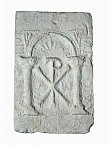Plate with Christogram

The relief plate seems rather inconspicious by its flat relief, but it is worth a second look. Framed by two columns on which an adorned arch rests, two Greek letters, Chi (X) and Rho (P), appear in the center of the representation. This combination of letters is well-known as an abbreviation of certain words, such as Chronos. We are familiar with the Christian meaning of the combination of Chi (X) and Rho (P) since the beginning of 4th century. Here, it stands for Christ. Its popularity is connected with an event written about for the first time by Lactanz in 318. He reported that the emperor Konstantin I had had a vision the night before an important battle against the army of the Maxentius. The vision told him that he should command his army by Christ’s sign, and that he should obtain this sign from a Chi twisted to the vertical and with its upper top turned round (cf. gravestone of the Ludino). Konstantin won his battle. The sign of victory, Christ’s sign, became very popular. It occurs in different forms: in the form that Lactanz described and in the form visible on this plate. However, we also have a sign which results from the combination of the letters Iota (I) and Chi (X) and/or combinations of these variants.

